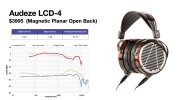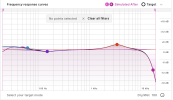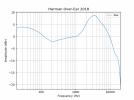- Joined
- Jun 18, 2024
- Messages
- 139
- Likes
- 96
I've been harping on a few things in the forum, and I'm noticing that I am either missing something huge (which I'd be grateful to understand better) or I'm onto something, but I need more information. Perhaps it's a bit of both.
Here's some context.
I use Sonarworks to calibrate my headphones for mixing on the road. One thing I did that changed a lot of how I perceive audio was I bought a pair of custom Tuned headphones from Sonarworks as well as a handy little perceptual plugin called tonal balance control.
The goal was to be able to accurately hear what tonal balance control is telling me. Eg if there is missing 2k information, I should be able to hear that issue in the headphones. What I've noticed is that I hear it more with some sort of Harman type curve. So my mind has been blown this week looking into how to perfect a curve for my ears.
What I know for sure is that these headphones I've got are utterly and completely flat. And what I am learning now is that in headphones, "flat does not = perceptually neutral).
So I need to clarify terms. I see "flat response" as a hardware technical term relating to the frequency response of a given speaker/headphone not coloured by our ears.
Neutral is a qualitative description of the tonal shape of a speaker.
Does this make sense?
What I want to do now is add in a smooth Harman curve to these flat response headphones to see if I can create a really smooth and neutral, natural speaker-like sound out of them.
As a though experiment, let's say a pair of headphones measured a straight line across the frequency spectrum. What would need to be done on an EQ to give these theoretical cans a Harman curve?
Second, I see two variations of Harman curves ... One is for headphones .. like this (I think we use a newer one?)
 the other is for speakers, which seems to be somethin like an HF rolloff that starts at 1khz and is more than a few db down at 24khz relative to 0db (ala Bob Katz).
the other is for speakers, which seems to be somethin like an HF rolloff that starts at 1khz and is more than a few db down at 24khz relative to 0db (ala Bob Katz).
Am I missing something with that, or is the Harman type curve different from headphones to speakers? Is the speaker curve even a Harman curve?
I also have speakers that I've tuned to a flat response. So I'm wondering if the curve for those would look something like a tilt EQ that boosts below 100hz and starts rolling off at around 1khz, or for less bass boost, just a gentle rolloff that starts at 1khz.
I was a slowish convert, but the data is pointing me in the direction of mastering the harman curve, and therefore hopefully transforming my audio production practise.
Here's some context.
I use Sonarworks to calibrate my headphones for mixing on the road. One thing I did that changed a lot of how I perceive audio was I bought a pair of custom Tuned headphones from Sonarworks as well as a handy little perceptual plugin called tonal balance control.
The goal was to be able to accurately hear what tonal balance control is telling me. Eg if there is missing 2k information, I should be able to hear that issue in the headphones. What I've noticed is that I hear it more with some sort of Harman type curve. So my mind has been blown this week looking into how to perfect a curve for my ears.
What I know for sure is that these headphones I've got are utterly and completely flat. And what I am learning now is that in headphones, "flat does not = perceptually neutral).
So I need to clarify terms. I see "flat response" as a hardware technical term relating to the frequency response of a given speaker/headphone not coloured by our ears.
Neutral is a qualitative description of the tonal shape of a speaker.
Does this make sense?
What I want to do now is add in a smooth Harman curve to these flat response headphones to see if I can create a really smooth and neutral, natural speaker-like sound out of them.
As a though experiment, let's say a pair of headphones measured a straight line across the frequency spectrum. What would need to be done on an EQ to give these theoretical cans a Harman curve?
Second, I see two variations of Harman curves ... One is for headphones .. like this (I think we use a newer one?)
Am I missing something with that, or is the Harman type curve different from headphones to speakers? Is the speaker curve even a Harman curve?
I also have speakers that I've tuned to a flat response. So I'm wondering if the curve for those would look something like a tilt EQ that boosts below 100hz and starts rolling off at around 1khz, or for less bass boost, just a gentle rolloff that starts at 1khz.
I was a slowish convert, but the data is pointing me in the direction of mastering the harman curve, and therefore hopefully transforming my audio production practise.


